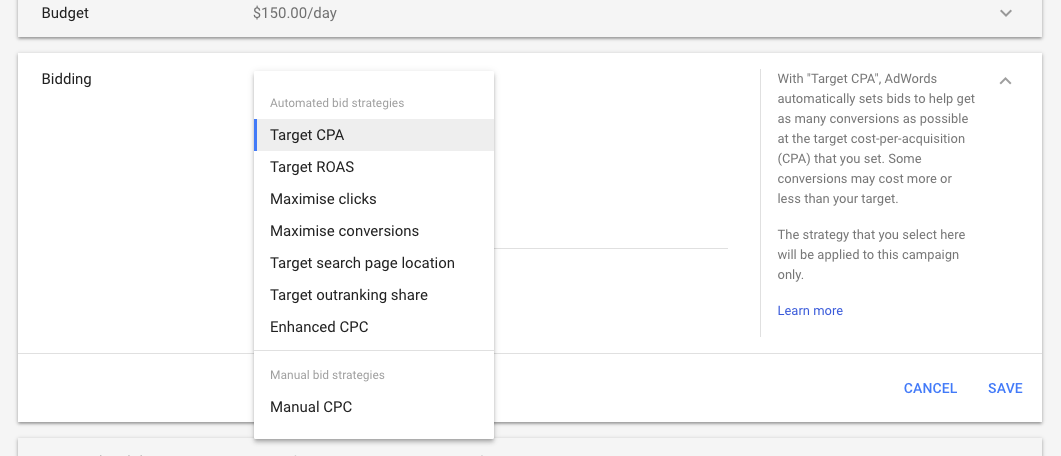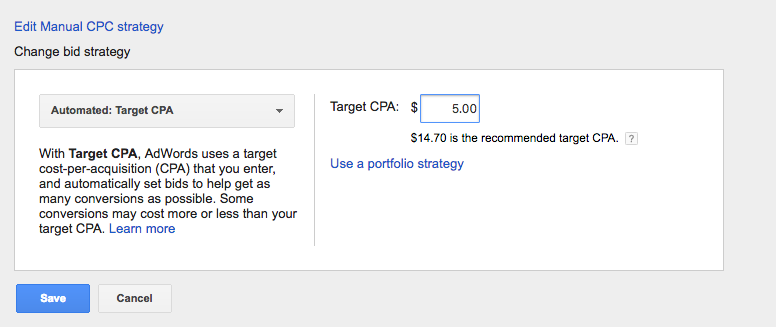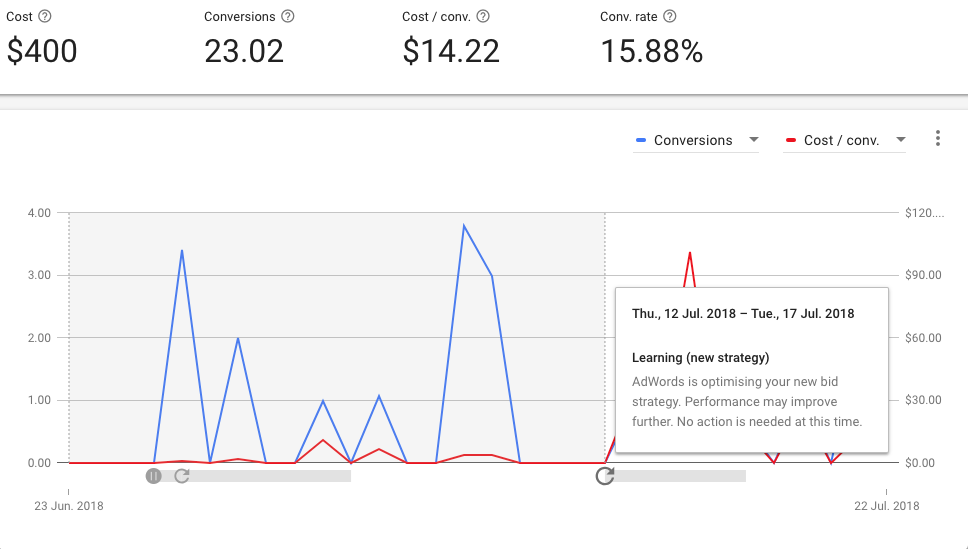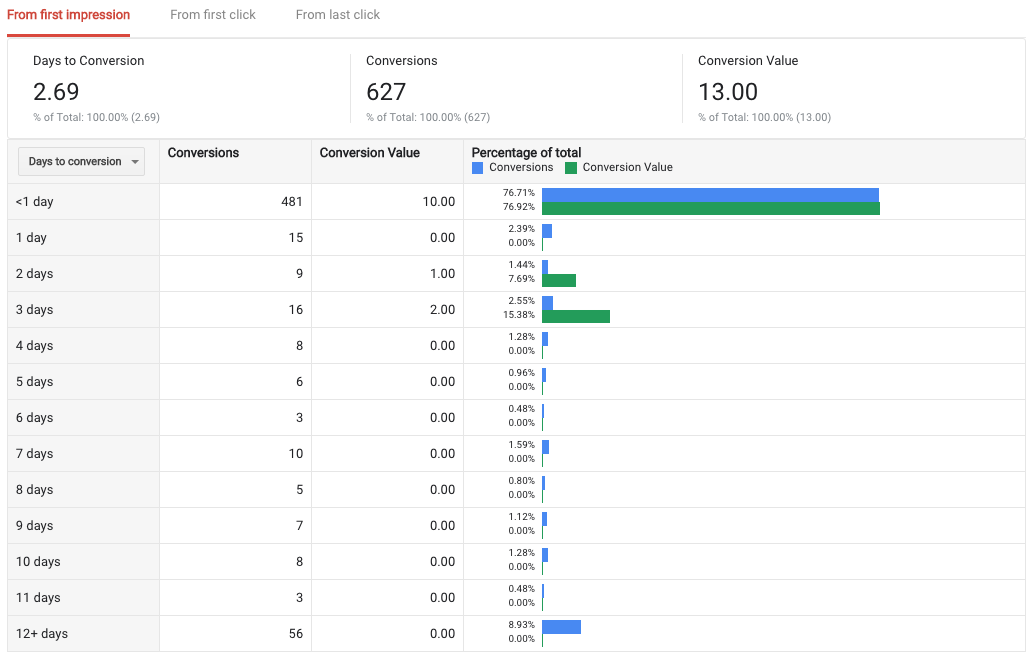Over the past couple of years, I have cut down the amount of time I spend in Google Ads (previously AdWords) by 75%, and yet the results I am achieving have gotten better and better.
How?
A solid strategy combined with clever use of automation.
What do I mean by a ‘solid strategy’? I combine data and experience-based reasoning with the campaigns I am about to build and run. Basically, just having a strategy behind what I am doing with the paid campaigns taken from a logical foundation of past results.
What do I mean by ‘automation’? In this case, Google’s Smart Bidding.
Google’s automated ‘Smart Bidding’ isn’t exactly a new feature. Enhanced Cost Per Click (CPC) has been around for a good few years, and after a few skeptical reviews to start, the true capability of Smart Bidding is something marketers are only just beginning to grasp onto and utilize. It is something that has only recently started winning marketers over.
But it doesn’t stop here.
Google Smart Bidding Strategies: The New Status Quo
Google now has seven different Automated Bid Strategies you can choose from — and that is just on the Search Network. Throw in Shopping, Video (YouTube), App and Display, and any future campaign types and updates; Automated Strategies are setting themselves up to be the default across any Google product.
 Google's 7 Automation Settings
Google's 7 Automation Settings
Here is how each type of automated bid strategy works:
Enhanced Cost Per Click (eCPC): Automatically adjusts your bids (up/down) depending on if a conversion is likely or unlikely. There is also a semi-automated version of this under ‘Manual CPC’ which you can enable by checking the ‘Enhanced CPC’ checkbox.
Maximize Conversions: Automatically set your bids to get as many conversions as possible within your campaign’s budget, but without caring about the Cost Per Conversion.
Target Cost Per Acquisition (tCPA): Automatically sets your bids to get as many conversions as possible within your CPA goal, but with no target on volume of conversions.
Target ROAS (tROAS): Set your bids to generate as much eCommerce revenue as possible within your target.
Target Search Page Location: Target your ad at the top of search results or onto the 1st page.
Target Outranking Share: Automatically outbid your competitors with the goal to appear above their ads.
Maximise Clicks: Automatically get the most clicks possible out of a certain budget.
Avoiding Common Smart Bidding mistakes
With the wrong strategy, automation can be a quick and easy way to spend all of your ad budgets and get absolutely nothing in return… being honest, I’ve done a couple of times myself, learning a lesson every time.
As someone who has used Artificial Intelligence (AI) and Machine Learning (ML) quite extensively across heaps of different platforms in various industries, and as someone who gets questioned on the topic often, I wanted to share what I think are six of the most common Smart Bidding mistakes someone can make… and how you can avoid making them with your campaigns.
Without further ado, and before your automated campaigns spend any more money, let’s get straight into it.
Tip #1: Don’t Push Your Luck When Trying to Drop Your Target CPA (tCPA)
Let’s start with the basics. Google’s automation reportedly works in an ‘I’m looking at the past 30 days of data, but I’m ignoring the last 7 days, just in case it is not all consistent’ fashion.
Knowing that, it is crucial that whatever you are asking the campaigns to achieve with your Target CPA or Target ROAS campaign settings is in line with what Google already knows how to perform.
Google’s Machine Learning works in a similar fashion. In simple terms, it learns from what is working and what isn’t working, then uses these learnings to run your campaigns.
If you have been getting $15 CPAs constantly for the past month and you ask Google to push for a $5 target CPA, you are in for a bad time.
 How not to use tCPA
How not to use tCPA
You want to make the most of your automated campaigns and get some awesome results, right? Right.
Google can deal with optimizing its own performance but here is the secret. Smaller, bite-sized drops in the Target CPA.
Here is the step-by-step breakdown of what I would do:
Step 1: Implement the Target CPA of $15 (or exactly what it suggests in the Google interface when you are changing the settings).
Step 2: Once you have a solid month’s worth of data AND the campaigns are performing in the way you would like them to be (around $15 CPA), lower the target by around 5%, definitely no more than 10%. In this case, I would knock it down to $14.
Step 3: Monitor the performance of this change after another month or so reevaluate campaign performance - I have seen these optimizations both over-perform and under-perform, so it is important you are monitoring closely.
Step 4: If your Target CPA/ROAS optimization didn’t work, you have likely committed one of the crimes noted in this very list (probably a major change to the campaign which has pushed it back into the learning phase).
Summary: Don’t push your luck. Let Google get comfortable with the goal then slowly nudge it down/up from there. If you are optimizing a campaign with a hell of a lot of volume (conversions), the timeframe between pushing your bids up or down can be less than a month. But, as I say, keep an eye on it.
Tip #2: Don’t Focus on a Metric That Isn’t Your Goal
Are you looking at the wrong metrics? This one is more to do with the marketer. If you are not fully aware of how automation works, you are likely looking at metrics such as your Average Cost Per Click (CPC), the Impression Share of each campaign and even the Average Position that your ads are displaying in.
News flash - these aren’t in your control anymore.
Google knows more about the people we are targeting than we ever will, and the way it utilizes this data is by displaying your ad when it reaches a level of confidence only it can possess — which ends up causing certain metrics to ‘drop’ or look like they are underperforming.
Here is an example: John needs a new pair of socks. Which is great, we sell socks!
Google knows that John has been searching reviews of the best sock retailers and reviewing articles on the top things to look out for when buying socks, so Google knows he is a hot prospect and is in the market to buy.
Because Google knows this, it decides to throw our ad into the auction in an attempt to win John’s click - it will likely also bid very competitively for this, sometimes way above what you would bid manually.
Vice versa to this, if Google isn’t classifying a user as qualified, it WON’T show your ad, thus losing impression share.
Anyone looking at these metrics when analyzing performance isn’t monitoring what matters most — conversions.
With automation you are passing the control into Google’s hands so it can analyze millions of signals all at once, so don’t judge it on not performing for a metric that isn’t your goal, i.e., Average Position. If you want to maintain a specific ad position, there are scripts and campaign settings out there for this (this is a whole different strategy, for another day).
Summary: Conversions are your goal, so use that as your metric that matters (and have faith in your automated strategy to perform).
Tip #3: Be Patient and Give it Time to Learn
There is actually a large element of patience involved in automated bidding strategies - which I know, is a real pain in the butt with strategies (and keeping clients happy if results aren’t awesome).
But, as we all do with new things, Google goes through something called a ‘learning period’ whenever you make a significant campaign chance (more on this later).
One big mistake a lot of marketers make is ending an automated test way before Google has even had the chance to learn what it needs to do. It is literally this simple — Google needs around 5-7 days to learn how best to use your budget, then it is out of the ‘testing’ phase and into optimization mode.
If you haven’t seen it before, whenever you hover over the automated campaign settings in your Google Ads interface, you will see the option to go through to the ‘Bid Strategy Report’, which looks a little like this:
 Google's Bid Strategy Report & Learning Period
Google's Bid Strategy Report & Learning Period
This handy tool clearly shows you what the learning phase is for your campaign, along with the actual performance DURING the learning phase. Here, in my example, you can see I have nowhere near enough data to say whether it is or isn’t working. So guess what? I will leave it be.
Summary: Leave your campaigns alone until they are out of the learning period. Any changes you make reset your data, and you lose out on any time Google spent trying to do your work for you.
Tip #4: Don’t Overlook High Conversion Delay When Analyzing Performance
If you don’t know much about conversion delays and how to improve your campaigns accordingly, leave me a comment below, and I will write up a guide — or there are heaps of resources online that can help you out (super important when running paid ads to consider).
In short, the Google Ads conversion pixel runs (by default) on a 30-day attribution window. If your user clicks an ad today but doesn’t convert for 3 weeks — guess what, Google claims it, even if it wasn’t the last click of the conversion.
If your conversion cycle is naturally quite long (i.e., the time between a user clicking your ad and actually converting is multiple days or weeks rather than on the day), you are at risk of under-weighting your campaign’s performance.
(Not sure on how to find your conversion time lag? You can get to it pretty easily in the Google Ads interface: Tools > Search Attribution > Paths > Time Lag + Path Length - you can view from the user’s first impression, first click or last click.)
 Conversion Time Lag
Conversion Time Lag
Let’s say that you are about to run an experiment with your best performing campaign, testing Target CPA against Manual CPC. You set up the test, and away you go. At the end of the 2-week experiment, your Manual CPC campaign has 10 conversions, but your Target CPA only has 7.
Because the Manual CPC campaign has been running previously, users that have clicked your ads in the past 30 days still have that ads cookie data with them, so when they convert it is attributed back to that campaign. Contrary to that, the Target CPA campaign may have chosen 20 of the most perfect lead targets in the world to show your ad, but if your conversion delay is 3 weeks on average, you are only going to see those conversions start coming in after the 3 weeks have elapsed.
Summary: If you are comparing the performance of an automated campaign, it may not look as strong because some of the people who clicked your ad haven’t converted yet. These conversions will inevitably come later on but because your spend is fully reported, it may appear that you have fewer conversions, a higher CPA, or the campaigns just aren’t profitable.
Tip #5: Consider Campaign Budget Headroom or Accelerating Budget
It sounds stupid typing it and as a marketer, it is almost hard to hear, but limiting your campaign budget can cost you conversions, at a cheaper price. Using the most extreme example, if we were to launch a new campaign right now with a Target CPA of $10, then set the campaign budget to $5, it is going to be very hard for Google to perform the right daily optimizations to achieve this goal for you.
This is known as not allowing enough budget headroom (also known as being silly).
 Uh-oh... Budget Constrained
Uh-oh... Budget Constrained
Daily campaign budget is a difficult one to apply a ‘best practice’ to, as it really depends on the volume of leads you need for your business, but a good start is to do the basic division of your monthly budget by 30 (or specifically 30.4) and go from there.
For marketers wanting to get a little more specific with their campaign forecasting and budgeting, you can use tools such as SEMrush's Keyword Magic Tool or Google's Keyword Planner to cross-reference your targeted keywords with rough monthly search volumes and average cost per clicks to calculate a required monthly spend for each campaign.
Note: Google can actually spend up to 200% of your set budget on any given day — so again, keep track.
There are some exceptions though. Like with Google’s newer Smart Display campaigns, they have a ‘recommended’ daily budget of 20x the Target CPA to allow Google’s Machine Learning to do the right amount of groundwork and testing to get the best results.
The accelerating budget ‘issue’ is something which a lot of marketers disagree with, but Google’s best practice states that you should keep all automated campaign settings to Standard delivery method.
Why? It comes back to control.
Google doesn’t want to be ‘forced’ to show your ad to someone just because you say so, it is like a grouchy teenager — it wants to do what it wants when it wants. Except Google is a grouchy teenager with a lot of data to back itself up, so we should listen (the majority of the time).
Why would you want to have an Accelerated delivery method then?
There are a few reasons that marketers are pushing, but the most used come back to existing campaigns that are performing well, in niche industries. Having the campaign setting as Accelerated will only ensure your ad is shown to more available searches / users, and if your CPA is admirable currently, what have you got to lose by testing?
Summary: Leave your campaigns on Standard delivery method to begin with, and give each campaign a bit of breathing space to test it’s bidding strategies.
Tip #6: Avoid Continuously Making Major Changes to Campaigns
Saving the best till last; this is the big one, and I can’t count the number of times I have done it myself.
I will make it as simple as possible — every time you make a major change to your campaign, you reset the learning period and start back from day 1.
Remember, the ‘Learning’ status indicates that AdWords is gathering performance data which it uses to optimize bids, so if you hover over the bubble on your campaigns and it shows ‘learning’ you have likely:
Only just created the strategy.
Changed the daily budget or shared budget- careful of that one, it is an easy mistake to make.
Changed a setting from your conversion tab - i.e., the conversion setting OR the conversion action setting.
Altered campaigns, ad groups or keywords related to the bidding strategy - this includes adding and removing ad groups or keywords. Yes, really.
So what are you supposed to do?
It is simple. Just like Tip #3, be patient and wait for Google to learn your new strategy.
Summary: Changing bid strategy settings often will prolong the learning period and prevent Google from accurately adjusting bids to meet your targets/goals, so sit tight and be patient with your optimizations and Google’s famous AI.
To Conclude
There are six smart bidding pitfalls to avoid and strategies you can use to make the most from your Google Ads campaigns:
Don’t push your luck when trying to drop your Target CPA (tCPA). Take an incremental approach.
Don’t focus on a metric that isn’t your goal. If your bidding strategy is optimizing for conversions, that is what you should be looking at.
Leave your campaigns alone until they are out of the learning period. Be patient and give them time.
Don’t overlook high conversion delay when analyzing performance.
Consider campaign budget headroom or accelerating budget. Give each campaign a bit of breathing space to test it is bidding strategies.
Avoid continuously making major changes to campaigns. Sit tight and wait for Google to learn your new strategy.
To wrap things up, it all ties back to having faith in your automated strategy (and yourself). If what you have set up is well thought through and is based on data and clear strategy, you shouldn’t need to keep making changes to your campaigns, altering budgets or continuously checking in on your results; you will know that you are heading in the right direction.
If you have learned any other pitfalls or tips I should consider I would love to hear them; let me know in the comments or flick me a message on LinkedIn here.
Innovative SEO services
SEO is a patience game; no secret there. We`ll work with you to develop a Search strategy focused on producing increased traffic rankings in as early as 3-months.
A proven Allinclusive. SEO services for measuring, executing, and optimizing for Search Engine success. We say what we do and do what we say.
Our company as Semrush Agency Partner has designed a search engine optimization service that is both ethical and result-driven. We use the latest tools, strategies, and trends to help you move up in the search engines for the right keywords to get noticed by the right audience.
Today, you can schedule a Discovery call with us about your company needs.
Source:





